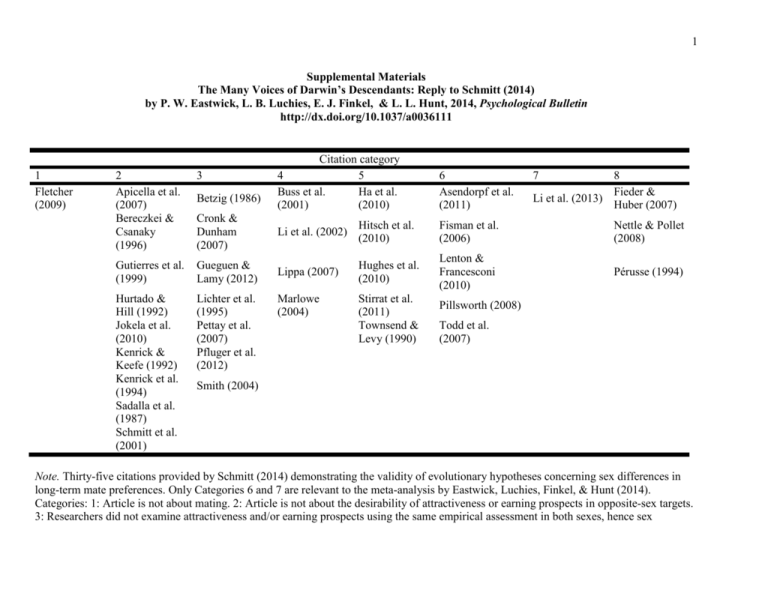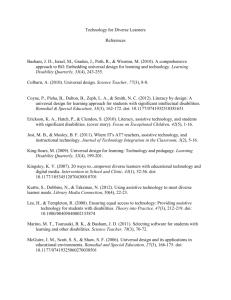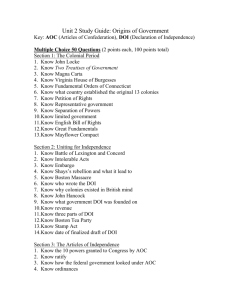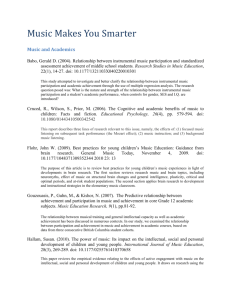BUL-BUL2-Eastwick_Supp.Mat
advertisement

1 Supplemental Materials The Many Voices of Darwin’s Descendants: Reply to Schmitt (2014) by P. W. Eastwick, L. B. Luchies, E. J. Finkel, & L. L. Hunt, 2014, Psychological Bulletin http://dx.doi.org/10.1037/a0036111 1 Fletcher (2009) 2 Apicella et al. (2007) Bereczkei & Csanaky (1996) 3 Gutierres et al. (1999) Gueguen & Lamy (2012) Hurtado & Hill (1992) Jokela et al. (2010) Kenrick & Keefe (1992) Kenrick et al. (1994) Sadalla et al. (1987) Schmitt et al. (2001) Lichter et al. (1995) Pettay et al. (2007) Pfluger et al. (2012) Betzig (1986) Cronk & Dunham (2007) Citation category 4 5 Buss et al. Ha et al. (2001) (2010) 6 Asendorpf et al. (2011) 7 8 Fieder & Li et al. (2013) Huber (2007) Li et al. (2002) Hitsch et al. (2010) Fisman et al. (2006) Nettle & Pollet (2008) Lippa (2007) Hughes et al. (2010) Lenton & Francesconi (2010) Pérusse (1994) Marlowe (2004) Stirrat et al. (2011) Townsend & Levy (1990) Pillsworth (2008) Todd et al. (2007) Smith (2004) Note. Thirty-five citations provided by Schmitt (2014) demonstrating the validity of evolutionary hypotheses concerning sex differences in long-term mate preferences. Only Categories 6 and 7 are relevant to the meta-analysis by Eastwick, Luchies, Finkel, & Hunt (2014). Categories: 1: Article is not about mating. 2: Article is not about the desirability of attractiveness or earning prospects in opposite-sex targets. 3: Researchers did not examine attractiveness and/or earning prospects using the same empirical assessment in both sexes, hence sex 2 differences cannot be calculated. 4: Article examined stated preferences. 5: Article examined hypothetical/online dating contexts. 6: Article was included in the meta-analysis. 7: Article was appropriate for the meta-analysis but was unavailable at the time. 8: Articles with actor/partner effect ambiguity (see text of reply to Schmitt). 3 References for Supplementary Online Table Apicella, C. L., Feinberg, D. R., & Marlowe, F. W. (2007). Voice pitch predicts reproductive success in male hunter-gatherers. Biology Letters, 3, 682-684. doi:10.1098/rsbl.2007.0410 Asendorpf, J. B., Penke, L., & Back, M. D. (2011). From dating to mating and relating: Predictors of initial and long-term outcomes of speed-dating in a community sample. European Journal of Personality, 25, 16-30. doi:10.1002/per.768 Bereczkei, T., & Csanaky, A. (1996). Mate choice, marital success, and reproduction in a modern society. Ethology & Sociobiology, 17, 17-35. doi:10.1016/0162-3095(95)00104-2 Betzig, L. (1986). Despotism and differential reproduction: A Darwinian view of history. New York, NY: Aldine. Buss, D. M., Shackelford, T. K., Kirkpatrick, L. A., & Larsen, R. J. (2001). A half century of mate preferences: The cultural evolution of values. Journal of Marriage & Family, 63, 491-503. doi:10.1111/j.1741-3737.2001.00491.x Cronk, L., & Dunham, D. (2007). Amounts spent on engagement rings reflect aspects of male and female mate quality. Human Nature, 18, 329-333. doi:10.1007/s12110-007-9018-9 Fieder, M., & Huber, S. (2007). The effects of sex and childlessness on the association between status and reproductive output in modern society. Evolution and Human Behavior, 28, 392–398. doi:10.1016/j.evolhumbehav.2007.05.004 Fisman, R., Iyengar, S. S., Kamenica, E., & Simonson, I. (2006). Gender differences in mate selection: Evidence from a speed dating experiment. Quarterly Journal of Economics, 121, 673–697. doi:10.1162/qjec.2006.121.2.673 4 Fletcher, J. M. (2009). Beauty vs. brains: Early labor market outcomes of high school graduates. Economics Letters, 105, 321–325. doi:10.1016/j.econlet.2009.09.006 Guéguen, N., & Lamy, L. (2012). Men’s social status and attractiveness: Women’s receptivity to men’s date requests. Swiss Journal of Psychology/Schweizerische Zeitschrift für Psychologie/Revue Suisse de Psychologie, 71, 157-160. Gutierres, S. E., Kenrick, D. T., & Partch, J. J. (1999). Beauty, dominance, and the mating game: Contrast effects in self-assessment reflect gender differences in mate selection. Personality and Social Psychology Bulletin, 25, 1126-1134. doi:10.1177/01461672992512006 Ha, T., Overbeek, G. E., & Engels, R. C. M. E. (2010). Effects of attractiveness and social status on dating desire in heterosexual adolescents: An experimental study. Archives of Sexual Behavior, 39, 1063-1071. doi:10.1007/s10508-009-9561-z Hitsch, G. J., Hortaçsu, A., & Ariely, D. (2010). Matching and sorting in online dating. American Economic Review, 100, 130–163. doi:10.1257/aer.100.1.130 Hughes, S. M., Farley, S. D., & Rhodes, B. C. (2010). Vocal and physiological changes in response to the physical attractiveness of conversational partners. Journal of Nonverbal Behavior, 34, 155–167. doi:10.1007/s10919-010-0087-9 Hurtado, A. M., & Hill, K. R. (1992). Paternal effect on offspring survivorship among Ache and Hiwi hunter-gatherers: Implications for modeling pair-bond stability. In B. S. Hewlett (Ed.), Father–child relations: Cultural and biosocial contexts (pp. 31–55). New York, NY: Aldine de Gruyter. 5 Jokela, M., Rotkirch, A., Rickard, I. J., Pettay, J., & Lummaa, V. (2010). Serial monogamy increases reproductive success in men but not in women. Behavioral Ecology, 21, 906– 912. doi:10.1093/beheco/arq078 Kenrick, D. T., & Keefe, R. C. (1992). Age preferences in mates reflect sex differences in human reproductive strategies. Behavioral and Brain Sciences, 15, 75–91. doi:10.1017/S0140525X00067595 Kenrick, D. T., Neuberg, S. L., Zierk, K. L., & Krones, J. M. (1994). Evolution and social cognition: Contrast effects as a function of sex, dominance, and physical attractiveness. Personality and Social Psychology Bulletin, 20, 210-217. doi:10.1177/0146167294202008 Lenton, A. P., & Francesconi, M. (2010). How humans cognitively manage an abundance of mate options. Psychological Science, 21, 528-533. doi:10.1177/0956797610364958 Li, N. P., Bailey, J. M., Kenrick, D. T., & Linsenmeier, J. A. W. (2002). The necessities and luxuries of mate preferences: Testing the tradeoffs. Journal of Personality and Social Psychology, 82, 947-955. doi:10.1037/0022-3514.82.6.947 Li, N. P., Yong, J. C., Tov, W., Sng, O., Fletcher, G. J., Valentine, K. A., . . . Balliet, D. (2013). Mate preferences do predict attraction and choices in the early stages of mate selection. Journal of Personality and Social Psychology, 105, 757–776. doi:10.1037/a0033777 Lichter, D. T., Anderson, R. N., & Hayward, M. D. (1995). Marriage markets and marital choice. Journal of Family Issues, 16, 412-431. doi:10.1177/019251395016004001 6 Lippa, R. A. (2007). The preferred traits of mates in a cross-national study of heterosexual and homosexual men and women: An examination of biological and cultural influences. Archives of Sexual Behavior, 36, 193-208. doi:10.1007/s10508-006-9151-2 Marlowe, F. W. (2001). Male contribution to diet and female reproductive success among foragers. Current Anthropology, 42, 755–760. doi:10.1086/323820 Nettle, D., & Pollet, T. V. (2008). Natural selection on male wealth in humans. The American Naturalist, 172, 658–666. doi:10.1086/591690 Pérusse, D. (1994). Mate choice in modern societies. Human Nature, 5, 255–278. doi:10.1007/BF02692154 Pettay, J. E., Helle S., Jokela, J., & Lummaa, V. (2007). Wealth class-specific natural selection on female life-history traits in historical human populations. PLOS ONE, 2(7), e606. doi:10.1371/journal.pone.0000606 Pflüger, L. S., Oberzaucher, E. K., Holzleitner, I. J., & Grammer, K. (2012). Cues to fertility: Perceived attractiveness and facial shape predict reproductive success. Evolution and Human Behavior, 33, 708-714. doi:10.1016/j.evolhumbehav.2012.05.005 Pillsworth, E. G. (2008). Mate preferences among the Shuar of Ecuador: Trait rankings and peer evaluations. Evolution and Human Behavior, 29, 256-267. doi:10.1016/j.evolhumbehav.2008.01.005 Sadalla, E. K., Kenrick, D. T., & Vershure, B. (1987). Dominance and heterosexual attraction. Journal of Personality and Social Psychology, 52, 730-738. doi:10.1037/00223514.52.4.730 7 Schmitt, D. P., Couden, A., & Baker, M. (2001). Sex, temporal context, and romantic desire: An experimental evaluation of sexual strategies theory. Personality and Social Psychology Bulletin, 27, 833–847. doi:10.1177/0146167201277006 Smith, E. A. (2004). Why do good hunters have higher reproductive success? Human Nature, 15, 343-364. doi:10.1007/s12110-004-1013-9 Stirrat, M., Gumert, M., & Perrett, D. (2011). The effect of attractiveness on food sharing preferences in human mating markets. Evolutionary Psychology, 9, 79-91. Todd, P. M., Penke, L., Fasolo, B., & Lenton, A. P. (2007). Different cognitive processes underlie human mate choices and mate preferences. Proceedings of the National Academy of Sciences, USA, 104, 15011-15016. doi:10.1073/pnas.0705290104 Townsend, J. M., & Levy, G. D. (1990). Effects of potential partners’ physical attractiveness and socioeconomic status on sexuality and partner selection. Archives of Sexual Behavior, 19, 149–164.





